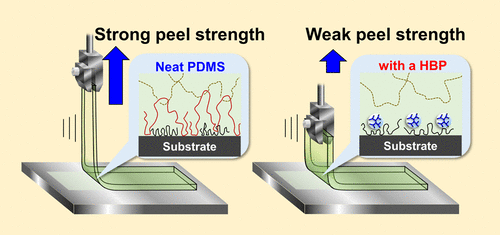当前位置:
X-MOL 学术
›
ACS Macro Lett.
›
论文详情
Our official English website, www.x-mol.net, welcomes your
feedback! (Note: you will need to create a separate account there.)
Adhesion Control of Elastomer Sheet on the Basis of Interfacial Segregation of Hyperbranched Polymer
ACS Macro Letters ( IF 5.1 ) Pub Date : 2019-02-26 00:00:00 , DOI: 10.1021/acsmacrolett.8b00971 Manabu Inutsuka , Masayuki Haraguchi 1 , Masaaki Ozawa 1 , Norifumi L Yamada 2 , Keiji Tanaka
ACS Macro Letters ( IF 5.1 ) Pub Date : 2019-02-26 00:00:00 , DOI: 10.1021/acsmacrolett.8b00971 Manabu Inutsuka , Masayuki Haraguchi 1 , Masaaki Ozawa 1 , Norifumi L Yamada 2 , Keiji Tanaka
Affiliation

|
Adhesion of a model rubbery material, cross-linked poly(dimethylsiloxane) (PDMS), onto a solid surface was studied by sum-frequency generation spectroscopy and X-ray photoelectron spectroscopy. To do so, here, we have focused on the adhesive deposit and insoluble layer. The former and latter were defined as the residual amount on the substrate after the peeling and residual layer after washing with a good solvent, respectively. The peel strength of a PDMS sheet adhered onto a glass plate increased with the contact time. Both adhesive deposit and insoluble layer also exhibited comparable contact time dependence. Once a hyperbranched polymer (HBP), which was segregated to the adhesive interface, was incorporated into PDMS, the peel strength and adhesive deposit decreased, although the thickness of the insoluble layer remained almost unchanged. These results suggest that the formation of loosely adsorbed chains on the solid surface, which possess not only trains but also many loop portions and tail parts, plays an important role in the macroscopic adhesion behavior of the PDMS sheet and the interfacial segregation of HBP can prevent it.
中文翻译:

基于超支化聚合物界面偏析的弹性体片材附着力控制
通过和频发生光谱和 X 射线光电子能谱研究了模型橡胶材料、交联聚 (二甲基硅氧烷) (PDMS) 在固体表面上的粘附。为此,我们将重点放在粘合剂沉积物和不溶层上。前者和后者分别定义为剥离后基材上的残留量和用良溶剂洗涤后的残留层。粘附在玻璃板上的 PDMS 片材的剥离强度随着接触时间的增加而增加。粘合剂沉积物和不溶层也表现出相当的接触时间依赖性。一旦将分离到粘合剂界面的超支化聚合物 (HBP) 结合到 PDMS 中,剥离强度和粘合剂沉积物就会降低,尽管不溶层的厚度几乎保持不变。
更新日期:2019-02-26
中文翻译:

基于超支化聚合物界面偏析的弹性体片材附着力控制
通过和频发生光谱和 X 射线光电子能谱研究了模型橡胶材料、交联聚 (二甲基硅氧烷) (PDMS) 在固体表面上的粘附。为此,我们将重点放在粘合剂沉积物和不溶层上。前者和后者分别定义为剥离后基材上的残留量和用良溶剂洗涤后的残留层。粘附在玻璃板上的 PDMS 片材的剥离强度随着接触时间的增加而增加。粘合剂沉积物和不溶层也表现出相当的接触时间依赖性。一旦将分离到粘合剂界面的超支化聚合物 (HBP) 结合到 PDMS 中,剥离强度和粘合剂沉积物就会降低,尽管不溶层的厚度几乎保持不变。





















































 京公网安备 11010802027423号
京公网安备 11010802027423号